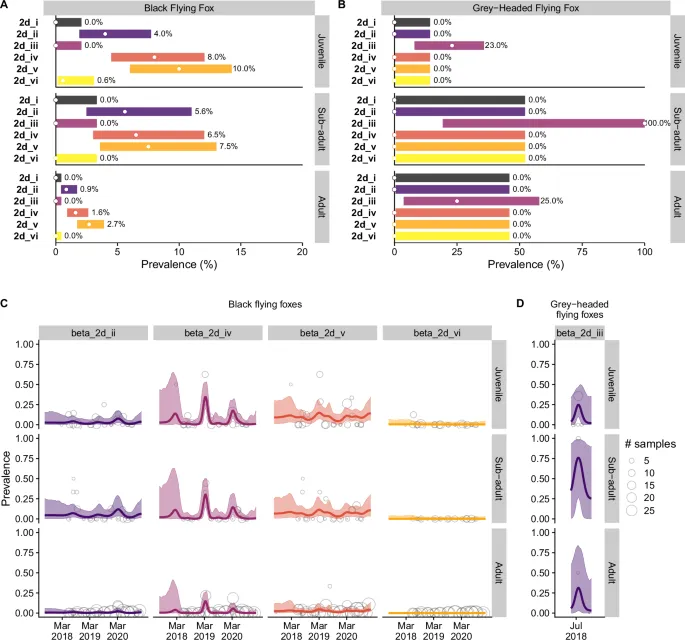Young Bats and Their Role in Coronavirus Evolution
The COVID-19 pandemic has thrust coronaviruses into the limelight, causing global concern and prompting extensive research. Recent studies have revealed a fascinating and concerning relationship between immature bats and the seasonal excretion of various coronaviruses. This phenomenon is closely tied to rates of coinfection in young bats, which poses a potential threat for the emergence of new viral strains. As scientists delve deeper into these complexities, understanding the dynamics in bat populations could help us prevent future outbreaks.
The Coinfection Conundrum
New research argues that young bats are uniquely susceptible to multiple strains of coronaviruses. Bats are known reservoirs for a number of zoonotic viruses, and their ability to host different pathogens without falling ill complicates the scenario. Immature bats often face environmental pressures, resulting in high rates of stress that can weaken their immune systems. This stress, coupled with their social behavior, appears to amplify the likelihood of concurrent infections by various coronavirus strains.
Seasonal Patterns of Coronavirus Excretion
Recent studies highlighted synchronized seasonal excretion patterns of coronaviruses among immature bats. During certain times of the year, these bats shed multiple strains of the virus into their environment. This synchronization can lead to increased contact between different strains of virus, setting the stage for potential recombination events that might yield new, more virulent strains.
The seasonal highs may coincide with environmental factors such as temperature fluctuations, food availability, and social behaviors during mating seasons. For scientists tracking bat populations, these seasonal patterns are vital in predicting and preparing for potential virus outbreaks.
Driving New Strains: The Risk Factor
The question on many minds is, what does this mean for human health? Bats can harbor and transmit viruses to other animals, including humans. As young bats potentially drive new strains through coinfection, the spillover effect into other species—and eventually humans—could present significant risks. The concept of spillover has already been implicated in previous coronavirus outbreaks, including SARS-CoV and MERS-CoV.
Furthermore, the ecological balance is precarious; as human activity continues to encroach on bat habitats, the potential for increased interactions will only escalate. The potential for young bats to create new strains could repeat the histories of diseases like Ebola and Zika.
Understanding Immune Responses
Research surrounding the immune responses of young bats to coronaviruses is still in its nascent stages. However, scientists have begun studying the innate immune responses of bats in an effort to understand their ability to coexist with multiple pathogens simultaneously. This research may provide insights into how these bats manage to live in harmony with viruses that would be lethal to other mammals.
By understanding these mechanisms, scientists might identify ways to bolster immune responses in other species at risk of similar zoonotic events, potentially mitigating impacts during outbreaks.
Field Studies and Data Collection
Effective management of wildlife populations becomes paramount as researchers strive to collect data on bat behaviors and virus excretion. Field studies focus on monitoring bat populations in both their natural habitats and in urban settings, leading to a better understanding of the adaptive behaviors of young bats amidst environmental stresses.
By categorizing and tracking individual bats, scientists can gather critical data on infection rates, strain variations, and excretion timelines. This information is invaluable in modeling potential virus emergence and evaluating which populations may present significant spillover risks.
Implications for Public Health and Wildlife Conservation
The intersection of public health and wildlife conservation efforts cannot be overstated. The emergence of new viruses is not just a concern for epidemiologists and health organizations but also calls for a unified approach to conservation. Understanding the dynamics of bat populations and their relationships with coronaviruses may drive initiatives to protect these critical species while safeguarding human health.
Strategies such as habitat conservation, responsible urban planning, and controlled interactions will be essential in maintaining a balance whereby both bats and humans can coexist. Surveillance and monitoring will need to be ongoing tasks for public health institutions, focusing not just on direct spillover events but also on understanding potential changes in bat population dynamics and their implications for disease emergence.
Looking Forward: Research, Awareness, and Prevention
As scientists continue to monitor these trends in bat populations and their associated coronaviruses, the lessons learned can shape future approaches to this interplay of wildlife and human health. The focus on young bats symbolizes not just a recognition of the problem but also a proactive stance towards understanding and preventing future zoonotic diseases.
In conclusion, the relationship between immature bats, their coinfection rates, and the subsequent potential for new coronavirus strains represents an area of major scientific and public health interest. Understanding this dynamic is essential for developing effective strategies that can mitigate future outbreaks and safeguard both wildlife and human populations.







